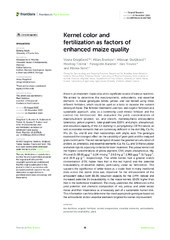Приказ основних података о документу
Kernel color and fertilization as factors of enhanced maize quality
| dc.creator | Dragičević, Vesna | |
| dc.creator | Brankov, Milan | |
| dc.creator | Stoiljkovic, Milovan | |
| dc.creator | Tolimir, Miodrag | |
| dc.creator | Travlos, Ilias | |
| dc.creator | Simić, Milena | |
| dc.date.accessioned | 2022-11-23T14:15:34Z | |
| dc.date.available | 2022-11-23T14:15:34Z | |
| dc.date.issued | 2022 | |
| dc.identifier.uri | http://rik.mrizp.rs/handle/123456789/1059 | |
| dc.description.abstract | Maize is an important staple crop and a significant source of various nutrients. We aimed to determine the macronutrients, antioxidants, and essential elements in maize genotypes (white, yellow, and red kernel) using three different fertilizers, which could be used as a basis to increase the nutrient density of maize. The fertilizer treatments used bio- and organic fertilizers as a sustainable approach, urea, as a commonly used mineral fertilizer, and the control (no fertilization). We evaluated the yield, concentration of macronutrient (protein, oil, and starch), nonenzymatic antioxidants (phenolics, yellow pigment, total glutathione (GSH), and phytic phosphorus), and reduction capacity of the 2,2-diphenyl-1-picrylhydrazyl (DPPH) radical, as well as essential elements that are commonly deficient in the diet (Mg, Ca, Fe, Mn, Zn, Cu, and S) and their relationships with phytic acid. The genotype expressed the strongest effect on the variability of grain yield and the analyzed grain constituents. The red-kernel hybrid showed the greatest accumulation of protein, oil, phenolics, and essential elements (Ca, Fe, Cu, and S) than a yellow and white hybrid, especially in the biofertilizer treatment. The yellow kernel had the highest concentrations of yellow pigment, GSH, phytic phosphorous, Mg, Mn, and Zn (19.61 µg g−1 , 1,134 nmol g−1 , 2.63 mg g−1 , 1,963 µg g−1 , 11.7 µg g−1 , and 33.9 µg g−1 , respectively). The white kernel had a greater starch concentration (2.5% higher than that in the red hybrid) and the potential bioavailability of essential metals, particularly under no fertilization. This supports the significance of white maize as a staple food in many traditional diets across the world. Urea was important for the enhancement of the antioxidant status (with 88.0% reduction capacity for the DPPH radical) and increased potential Zn bioavailability in the maize kernels (13.3% higher than that in the biofertilizer treatment). This study underlines the differences in the yield potential and chemical composition of red, yellow, and white-kernel maize and their importance as a necessary part of a sustainable human diet. This information can help determine the most appropriate genotype based on the antioxidants and/or essential elements targeted for kernel improvement. | sr |
| dc.language.iso | en | sr |
| dc.publisher | Lausanne : Frontiers | sr |
| dc.relation | info:eu-repo/grantAgreement/MESTD/inst-2020/200040/RS// | sr |
| dc.rights | openAccess | sr |
| dc.rights.uri | https://creativecommons.org/licenses/by/4.0/ | |
| dc.source | Frontiers in plant science | sr |
| dc.subject | bio-fertilizer | sr |
| dc.subject | organic fertilizer | sr |
| dc.subject | kernel composition | sr |
| dc.subject | essential elements | sr |
| dc.subject | antioxidants | sr |
| dc.subject | potential bio-availability | sr |
| dc.subject | yield | sr |
| dc.title | Kernel color and fertilization as factors of enhanced maize quality | sr |
| dc.type | article | sr |
| dc.rights.license | BY | sr |
| dc.citation.spage | 1 | |
| dc.citation.epage | 13 | |
| dc.identifier.doi | 10.3389/fpls.2022.1027618 | |
| dc.identifier.fulltext | http://rik.mrizp.rs/bitstream/id/5956/bitstream_5956.pdf | |
| dc.type.version | publishedVersion | sr |


